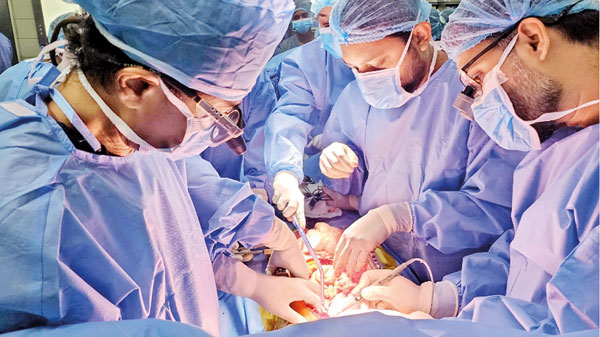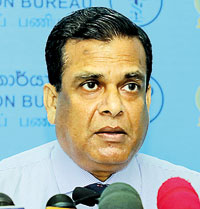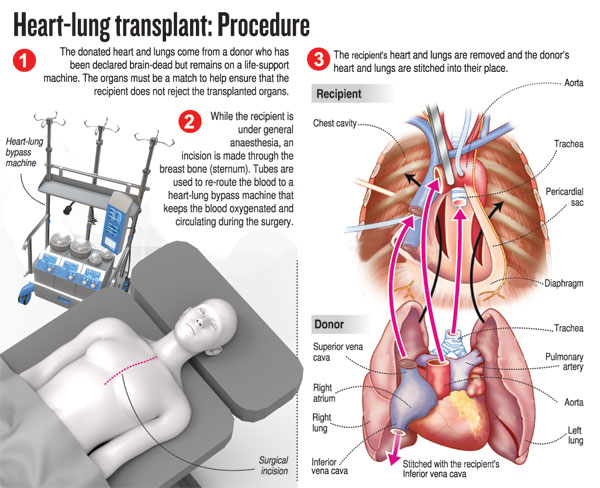News
Lanka’s first heart-lung transplant: 18-hour surgical marathon and trailblazing mission
View(s):By Kumudini Hettiarachchi
The nail-biting tension had been palpable within Colombo’s premier National Hospital of Sri Lanka (NHSL). Now the trailblazing mission is done and the recipient of the first heart-lung transplant is in recovery.
It was an 18-hour surgical marathon by a joint Indian-Sri Lankan team begun at 8.30 a.m. on March 23 (Thursday) going into the wee hours of the next day. The meticulous preparations at the NHSL had come way before that. The Indian team was from MGM Healthcare Hospital, Chennai.

The procedure that begun at 8.30 a.m. on March 23 (Thursday) went into the wee hours of the next day
Two days after this major feat, the Sunday Times exclusively reported it on March 26, headlined ‘Lanka reaches new heights with first-ever heart-lung transplant’.
There is a gentle smile a week later as the Sunday Times meets the Deputy Director General (DDG) of Health Services in charge of the NHSL, Dr. Kumara Wickremasinghe, and he dwells on the preparations made long before the transplant.
Naming the transplant a “complex and extraordinary” surgery, Dr. Wickremasinghe says “we were ready” when a deceased (brain-dead) donor was finally found to be compatible with the needs of the 50-year-old recipient.
It was back in the latter part of 2021 that the potential recipient came to them. There was no cure for her condition and the only option was a heart-lung transplant. (See box for details)

Dr. Kumara Wickremasinghe
So the NHSL kept her in the Cardiology Unit. “Such a transplant is no easy task,” said Dr. Wickremasinghe. Not only did they need special medications and consumables but also infrastructure.
The DDG then approached Health Minister Keheliya Rambukwella and a policy decision followed. He says that he appreciates the support of the Director General of Health Services, Dr. Asela Gunawardena, who issued a letter authorizing the NHSL to make the necessary preparations.
A message had also gone out to hospitals around the country that the NHSL had a patient who was in dire need of both the heart and lungs and were on the lookout for a deceased donor. Several came their way but assessments indicated that it would not be possible due to some issues in the donor’s respiratory tracts. The size of the organs to be donated also did not match the potential recipient.
Many meetings, meanwhile, both physically and on Zoom were also ongoing between the Sri Lankan and Indian teams, with the potential recipient’s condition being under observation throughout.
The much-awaited information finally came in March – there was a possible deceased donor, a teenage girl from Kurunegala. Thereafter, things moved quickly.
“It was a tense day and night (March 23),” recalls Dr. Wickremasinghe, the captain who steered the NHSL ship on uncharted waters with regard to this major transplant.
Paying major tribute to his staff, Dr. Wickremasinghe said a complex and pioneering heart-lung transplant could not have taken place if not for “immense” team work.
Regretting that he would not be able to name each and every one individually, he said that all of them had his heartfelt appreciation. On the Sri Lankan side, the Cardiothoracic Team was led by Dr. Mahendra Munasinghe and included Dr. Palinda Bandarage and Assistant Cardiothoracic Surgeon Dr. Kalhara Ranaweera; the Anaesthetic Team by Dr. Kumudini Ranatunga which included Dr. Malika de Silva and Dr. Dimuth Gunasena who was in the OT on that day; the Transplant Team by Dr. Ruwan Dissanayake; and the Respiratory Team by Dr. Amitha Fernando.
Consultant Cardiologist Dr. Wasantha Kapuwatte had looked after the recipient long before she got her new heart and lungs, been in the OT while it was happening and is seeing her now in the recovery stage as well. Also on hand were Consultant Thoracic Surgeon Dr. Sumana Handagala and another vital cog Consultant Microbiologist Dr. Mahen Kothalawala who keeps infection at bay. Another was the Health Ministry’s Director (Medical Services) & Coordinator of the National Transplant Programme, Dr. Ayanthi Karunarathne.
The DDG-NHSL reiterates the important role of Medical Officers of these teams; perfusionists; the strong support of the Nursing Team which includes Senior Grade Nursing Officers, Nursing Sisters & Nurses-in-Charge of the cardiothoracic OTs and ICUs; and the junior staff. “This mission could not have been accomplished without all these teams.”
The Indian Cardiothoracic Team was led by Dr. Srinath Vijayasekaran and included Dr. Senthilkumar Devarajan. While the coordination of the joint transplant had been efficiently handled by Dr. K.R. Balakrishnan, Anaesthetist Dr. Suresh Rao and nurses from MGM Healthcare Hospital had been very much a part of the procedure.
| More vigour for donor programme A good start for rare transplant procedures, is how Dr. Kumara Wickremasinghe describes this achievement, reminding Sri Lankans that there are numerous men, women and children awaiting organs to get a new lease of life.“We have a good National Organ Donor Programme for kidneys and livers which has been given more strength and vigour by this first heart-lung transplant,” he adds. The first heart transplant in Sri Lanka was performed at the Kandy Hospital in 2017 and the first lung transplant by a Japanese team at a private hospital in 2011.
| |
| When all systems were set to goIt was around 10 on the night of March 23. As Sri Lankans would have been getting ready for bed, those within the NHSL were wide awake.It was the time of reckoning for the multi-disciplinary team as they watched with bated breath – eyes glued to the operating table. The heart begins to beat and the lungs perform their duty of oxygenation of blood………. and relief floods the OT and tension ebbs away. A feat accomplished – the first heart-lung transplant in Sri Lanka! The heart-lung recipient, a medical specialist, is now conscious and on the path to recovery. Vigilance, however, is the need of the hour to support her full recovery, the Sunday Times understands. “The recipient had primary pulmonary hypertension which has no cure,” says a spokesperson for the Sri Lankan Cardiothoracic Surgical Team, explaining how there had been a gradual deterioration of her lungs which, in turn, had impacted on her heart. This had led to both lung and heart failure and she was oxygen-dependent. He says that the deceased donor, a teenage girl, had been assessed initially by the Kurunegala Teaching Hospital and found to be suitable for organ donation. Having got the consent of family members, she had then been transferred while on the ventilator, by ambulance to the NHSL’s Cardiothoracic Intensive Care Unit (ICU) on the night of March 22, where the secondary assessment was done. It was then that the decision was made to go ahead with the transplantation. The multi-disciplinary team on alert was assembled and on the morning of March 23, a comprehensive briefing carried out. All systems were set to go thereafter with two Operating Theatres (OTs) buzzing with life and hope. “The first step was to open the deceased donor’s chest from neck to abdomen in Cardiothoracic Theatre ‘C’ and inspect her heart and lungs, making way for the final-final decision to proceed with the transplantation,” the spokesperson said. The recipient, meanwhile, had been taken to the Transplant Theatre about 50 metres from the Cardiothoracic Theatre ‘C’. When she was anaesthetized, tense moments had ensued, as her heart stopped. Within 15 minutes, however, she was resuscitated, her chest opened up and she was connected to the heart-lung machine. “The lengthy process of the removal of the diseased heart and lungs followed. It took about three hours because we had to meticulously make way for the donor organs by preparing the chest, leaving behind cuffs when excising the trachea, aorta, inferior vena cava (IVC) and superior vena cava (SVC). The lungs also had to be removed systematically by excising the bronchi, pulmonary arteries and veins. We also had to control the bleeding from lots of abnormal vessels due to the diseased heart and lungs,” he says, creating images of the skills required. The organ retrieval team in Cardiothoracic Theatre ‘C’ was then given the green light to harvest the donor’s ‘heart and lung bloc’ followed by the liver and kidneys. Placed in an ice-box, the donor heart and lung bloc in preservation solution was carried the 50 metres to the Transplant Theatre where the implantation team began their task of connecting, through suturing, the donor trachea, aorta, IVC and SVC to the relevant cuffs in the recipient’s chest. The crucial steps that followed, according to the spokesperson were: n Perfusing the donor organs (heart and lungs) now in the recipient’s chest with the recipient’s blood, while she was connected to the heart-lung machine
The spokesman added that the deceased donor’s kidneys were sent to the Kandy National Hospital and Kurunegala Teaching Hospital and her liver to the Colombo North Teaching Hospital, Ragama, for transplantation. |

The best way to say that you found the home of your dreams is by finding it on Hitad.lk. We have listings for apartments for sale or rent in Sri Lanka, no matter what locale you're looking for! Whether you live in Colombo, Galle, Kandy, Matara, Jaffna and more - we've got them all!

